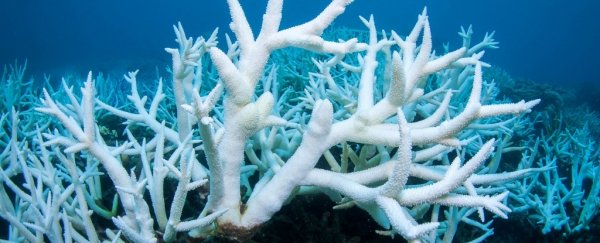Since the mid-1990s, coral in the Great Barrier Reef has declined by more than 50 percent, and that goes for virtually every species, at every depth, and in every size, according to a new study.
The research spanned the entire 2,300 kilometres of the Great Barrier Reef and found a disturbing loss at pretty much every level.
"A vibrant coral population has millions of small, baby corals, as well as many large ones - the big mamas who produce most of the larvae," explains Andy Dietzel from the ARC Centre of Excellence for Coral Reef Studies.
"Our results show the ability of the Great Barrier Reef to recover - its resilience - is compromised compared to the past, because there are fewer babies, and fewer large breeding adults."
Similar to old-growth forests, it is these larger corals that marine scientists are most concerned by.
Losing older coral like this could have a cascading effect on the whole reef system, as the largest colonies in a population disproportionately impact reproduction and the next generation's genes while also providing greater habitat and food for fish and other reef life.
"The global decline in large, old trees, for instance, implies a loss of critical habitat, food, and carbon storage," the authors write. But while the size of terrestrial forests has been carefully tracked over the years, trends in coral size are rarely examined; it's traditionally about coverage.
To fill this gap, researchers documented the systematic decline of coral abundance in the Great Barrier Reef across size, habitats, sectors, and taxa from 1995 to 2017. During that time, the reef experienced several local cyclones, four mass bleaching events, and two major outbreaks of the crown-of-thorns starfish (not to mention another severe bleaching event that occurred earlier this year).
Studying the vast expanse that is the Great Barrier Reef is obviously quite the challenge, and to estimate the size of colonies, researchers used line-intercept lengths as a proxy.
This means a line was placed upon the coral reef to measure the overarching length of various organisms below.
While not a direct measure of coral size, line-intercept lengths can indicate shifts in underlying colony size, and because it has been used for so long, the authors say it is "an irreplaceable source of historical demographic data" on corals.
The authors found an abundance of coral had declined sharply across all colony sizes and all coral taxa. These changes were most pronounced in the Northern and Central regions of the Great Barrier Reef, which is where most of the recent mass coral bleaching occurred.
"We used to think the Great Barrier Reef is protected by its sheer size," says marine biologist Terry Hughes, "but our results show that even the world's largest and relatively well-protected reef system is increasingly compromised and in decline."
The loss of medium and large colonies is particularly worrisome, as they could possibly stunt reproduction and stop older corals from replenishing shrinking populations. At the same time, the disproportionate loss in smaller colonies suggests a reduction in tiny coral larvae being spread about.
"The potential for recovery of older fecund corals is uncertain given the increasing frequency and intensity of disturbance events," the authors of the current study write.
"The systematic decline in smaller colonies across regions, habitats, and taxa suggests that a decline in recruitment has further eroded the recovery potential and resilience of coral populations."
And the window for recovery is closing fast. If we don't cut our emissions by the end of the century, studies show destructive bleaching events like those that occurred in 2016 and 2017 could very well occur on an annual basis.
"I think if we can control warming somewhere between 1.5-2 °C [above pre-industrial levels], as per the Paris agreement, then we'll still have a reef," Hughes told The Guardian.
"But if we get to 3-4 °C because of unrestrained emissions, then we won't have a recognisable Great Barrier Reef."
The study was published in the Proceedings of the Royal Society B.
